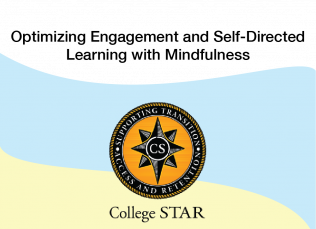
Using Mindfulness to Increase Student Self-Awareness and Self-Advocacy through First Year Seminar Style Courses
At Appalachian State University, most first-year students participate in a seminar class that emphasizes critical and creative thinking, effective communication, and the examination of a single issue from multiple perspectives. This case study focuses on assignments from these seminar classes that encourage self-awareness and self-monitoring.
This resource was originally developed with resources from the College STAR grant. That grant has ended and the College STAR modules will now permanently reside at the East Carolina University Office for Faculty Excellence.
Module Introduction
Most first year college students at Appalachian State University are required to take a First-Year Seminar course. These courses have a shared set of learning outcomes with primary emphasis on critical and creative thinking, communicating effectively, and examining a single issue from multiple perspectives. One of the benefits of first-year seminar courses at many universities, is the ability to blend the learning outcomes mentioned above with a topic-specific focus that brings students together who have common interests. Like other First Year Seminar instructors, I am keenly aware of the need to strike a balance between the topical focus and helping students develop the skills they need for college success. With this balance in mind, I incorporate some learning activities into my courses that help first year college students transition from reliance on parents to self-reliance. A large part of this self-reliance relates to recognizing and meeting their own needs. This ability to recognize they need help and to ask for that help is something that all students need to develop in order to be successful at asking professors for assignment clarification and support in understanding course content. This is true for any student, and especially so for the topic that binds students in my first-year seminar together – navigating the college transition for students with disabilities.
Whether the student has a disability or not, building a foundation of self-awareness and self-advocacy will be critical for them to accomplish their college goals. To this end, I infuse activities throughout my courses that help students become more aware of their own emotions, thoughts, strengths, challenges, and how they let others know what they need or desire. This case study explores mindfulness and other contemplative strategies used to help students develop the intrapersonal skills necessary to become strong self-advocates. Before students can self-advocate, they must have sufficient self-awareness to:
- Notice their physical and emotional selves,
- Recognize their thought patterns, desires, and unmet needs,
- Consider ways to meet those needs, and
- Communicate their needs and desires to others.
Some of the activities and tips included in this case study might be applicable to any first-year seminar, and others would be more appropriate for the students who have various disabilities. As you read the case study through that lens, apply the ideas that would be applicable to your specific situation. I teach two different sections of First Year Seminar. One focuses specifically on the autism spectrum. The other focuses on disability in general. The FYS focused on disability has been intentionally integrated with students in the Scholars with Diverse Abilities Program (a program at Appalachian State for students who have intellectual disabilities- something becoming more common on post-secondary campuses today thanks to the Higher Education Opportunity Act of 2008 (P.L. 110-315). Other instructional practices highlighted in this case study are drawn from another integrated seminar course I teach for the Scholars with Diverse Abilities Program. That course focuses on whole-person development throughout the transition to adulthood.
In this case study, only the assignments in these seminar courses meant to encourage student self-awareness and self-monitoring will be discussed. The specific practices offered here can be implemented effectively with students of all cognitive levels and would be useful for any freshman-seminar style class regardless of student population.
Support for this Module
Original development of this module was made possible by the College STAR (Supporting Transition Access and Retention) initiative. College STAR was a grant-funded project focused on partnering postsecondary educational professionals and students to learn ways for helping postsecondary campuses become more welcoming of students with learning and attention differences. Much of this work was made possible by generous funding from the Oak Foundation.
Organization/Publishers:
Share this resource:
Posted date:
November 10, 2022


